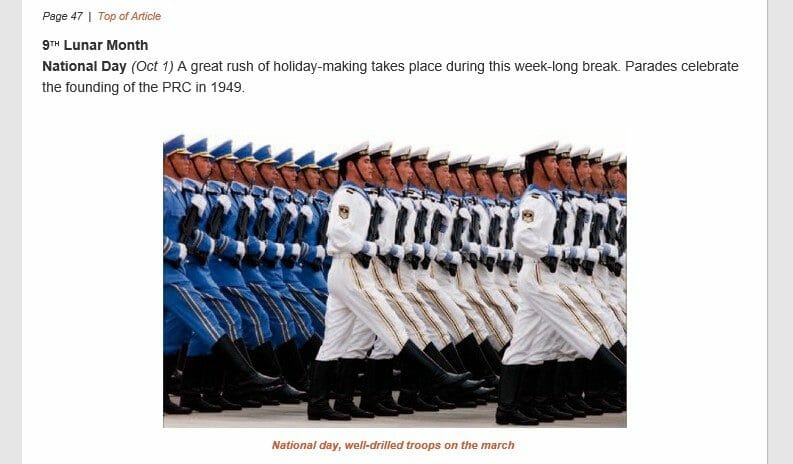By Cathy Huang
Chinese National Day is celebrated on October 1st every year to commemorate the founding of the People’s Republic of China with lots of large-scale activities held nationwide. It’s followed by ‘Golden Week’, a seven-day holiday from the 1st to the 7th of October, during which many Chinese people travel around the country and abroad.
There had been Chinese national celebrations in October prior to the establishment of the PRC as the removal of the final Chinese dynasty (the Qing) sprung from the Wuchang Uprising on 10th October 1911, after which Sun Yat-sen sought to consolidate a Republic. Consequently, for many years the nation commemorated the formation of the Republic in October. In 1945 The Western Daily Press and Bristol Mirror – one of the papers included in Gale’s British Library Newspapers digital archive – briefly described how National Day was celebrated in the region that year.
![China Celebrates National Day." Western Daily Press and Bristol Mirror [Yeovil, England] 11 Oct. 1945: 4. British Library Newspapers http://tinyurl.galegroup.com/tinyurl/3mkvR7 Sourced from the British Library, Gale Document Number: IS3245907717](http://blog.gale.cengage.co.uk/wp-content/uploads/2016/10/ChinaDay.jpg)
http://tinyurl.galegroup.com/tinyurl/3mkvR7 Sourced from the British Library, Gale Document Number: IS3245907717
One of the texts found in Gale Virtual Reference Library, entitled Berkshire Encyclopedia of China: Modern and Historic Views of the World’s Newest and Oldest Global Power provides an interesting description of the various ways National Day has been celebrated in the decades since 1949.

“From 1950 to 1959, National Day was routinely celebrated with a military parade in Tiananmen Square. The parade was discontinued in 1960 when the central government enforced stringent economic policies to combat widespread famine. Mass assemblies and processions took over in the 1960s. Starting from the early 1970s, organized and voluntary parties took place in parks throughout the country as a major form of National Day celebrations…
To boost the economy by encouraging tourism, the government created three controversial “Gold Weeks” in 1999 out of the festivals of Labor Day, National Day, and the Chinese New Year, making each a week-long holiday. An increasing number of Chinese people chose to spend the holiday touring the country and the world (first Southeast Asia and later Europe) …
An unwritten rule regulates the observance of National Day. Every tenth anniversary, there should a grand celebration and every fifth, a lesser one…
A national reception in the Great Hall of the People, as a token of thanks to foreigners working in China along with Chinese dignitaries, has become part of the National Day tradition. A top national leader customarily presides over the ceremony. Chinese embassies also hold receptions for overseas Chinese and dignitaries of hosting countries. Usually a fireworks display is held in cities nationwide. The one in Hong Kong at the Victoria Harbor is an exceptional spectacle, favored by residents as well as tourists.”1

Gale’s periodical and multimedia resource General OneFile also provides a first-hand account written by a tourist who visited the country when National Day celebrations were taking place. Published in International Travel News in 2006, it describes how extensively the population participated in the event.
“Unknown to us and everyone else in our 16-person tour group was the fact that the week of Oct. 1-8, honoring National Day, was the biggest of China’s three week-long holidays, called “golden weeks.” During National Day week, virtually everyone in China is on holiday and is encouraged to travel across the country to visit tourist sites and spend some of their savings.
…I offer here some excerpts about the Chinese tourists from the Oct. 4 China Daily newspaper, English edition: “In Beijing, a city management officer is quoted as saying he had never seen so many people in Tian’anmen Square as he did on Saturday. The three subway stops near the square were closed from Saturday to Tuesday due to overcrowding.”
According to the National Holiday Office, the major 126 scenic spots across China received 2.54 million tourists on Sunday alone.
In Beijing, visitors to the Forbidden City on Saturday exceeded its maximum capacity by 12%. The Summer Palace and the Temple of Heaven were equally overrun with tourists from all over China.
Most businesses close during China’s “golden weeks.” In hotels, business centers either close or curtail their operating hours.”
“‘Golden weeks’ in China.” International Travel News Feb. 2006: 11+. General OneFile, Gale Document Number: GALE|A141994534
Activities like flag-raising ceremonies, dance and song shows, firework displays, and painting and calligraphy exhibitions are also held to celebrate the National Day. If one loves shopping, National Day holiday is a great time, as many shopping malls offer big discounts during the holiday!
Please contact your Gale sales representative to trial any of our archives or databases.
Find more information, visit www.gale.cengage.co.uk
[1] Haiwang Yuan, “National Day.” Berkshire Encyclopedia of China: Modern and Historic Views of the World’s Newest and Oldest Global Power. Vol. 3. Great Barrington, MA: Berkshire Publishing, 2009. 1556-1557. Gale Virtual Reference Library, Gale Document Number: GALE|CX3008200470

